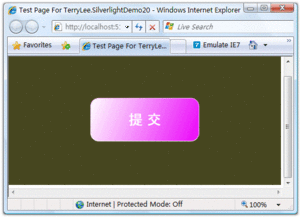MVVM Light - 用户控件作为视图视图、控件、用户、MVVM
I have decided to use the MVVM Light library to help design a UI. After tons of research and trial and error, I have yet to find the answers I am looking for. I've googled and read each StackOverflow question I can find, however, my problem seems to be unique on SO.
I wish to design a UI with a single window and populate it with different Views/UserControls. I do NOT want a shared navigation bar among the UserControls nor do I want multiple windows to pop-up. Each View/UserControl should bind to its own ViewModel, while the MainWindow will bind to a MainViewModel.

Example scenario - MainWindow with 3 UserControls
1. MainWindow populates with first UserControl which has a listbox and 3 buttons, the first button is enabled.
2. User clicks the first button.
3. MainWindow populates with second UserControl.
Or, additionally
2. User selects choice from a listbox, button two and three become available.
3. User clicks second/third button.
4. MainWindow populates with second/third UserControl.
Etc, etc.
Perhaps my approach isn't realistic, but I feel this has to be possible. I do not understand how to make all of these pieces work conceptually. There is no way my desires are unique. If you feel this is duplicate question, please redirect. Cheers.
To make things easier to understand, I've included some classes below. First, my App.xaml.
<Application x:Class="Bobcat_BETA.App"
xmlns="http://schemas.microsoft.com/winfx/2006/xaml/presentation"
xmlns:x="http://schemas.microsoft.com/winfx/2006/xaml"
xmlns:d="http://schemas.microsoft.com/expression/blend/2008"
xmlns:mc="http://schemas.openxmlformats.org/markup-compatibility/2006"
xmlns:views="clr-namespace:Bobcat_BETA.UserControls"
xmlns:vm="clr-namespace:Bobcat_BETA.ViewModels"
StartupUri="MainWindow.xaml"
mc:Ignorable="d">
<Application.Resources>
<vm:ViewModelLocator x:Key="Locator" d:IsDataSource="True" />
<DataTemplate DataType="{x:Type vm:SavedScenariosViewModel}">
<views:SavedScenariosUserControl />
</DataTemplate>
<DataTemplate DataType="{x:Type vm:ScenarioEditorViewModel}">
<views:ScenarioEditorUserControl />
</DataTemplate>
<DataTemplate DataType="{x:Type vm:SimulatorViewModel}">
<views:SimulatorUserControl />
</DataTemplate>
</Application.Resources>
</Application>
MainWindow.xaml
<Window x:Class="Bobcat_BETA.MainWindow"
xmlns="http://schemas.microsoft.com/winfx/2006/xaml/presentation"
xmlns:x="http://schemas.microsoft.com/winfx/2006/xaml"
Title="Bobcat - Version:0.00"
DataContext="{Binding Main, Source={StaticResource Locator}}">
<Grid>
<ContentControl Content="{Binding CurrentView}"/>
</Grid>
ViewModelLocator.cs
namespace Bobcat_BETA.ViewModels
{
public class ViewModelLocator
{
private static MainViewModel _main;
public ViewModelLocator()
{
_main = new MainViewModel();
}
[System.Diagnostics.CodeAnalysis.SuppressMessage("Microsoft.Performance",
"CA1822:MarkMembersAsStatic",
Justification = "This non-static member is needed for data binding purposes.")]
public MainViewModel Main
{
get
{
return _main;
}
}
}
}
MainViewModel.cs
namespace Bobcat_BETA.ViewModels
{
public class MainViewModel : ViewModelBase
{
private ViewModelBase _currentViewModel;
readonly static SavedScenariosViewModel _savedScenarioViewModel = new SavedScenariosViewModel();
readonly static ScenarioEditorViewModel _scenarioEditorViewModel = new ScenarioEditorViewModel();
readonly static SimulatorViewModel _simulatorViewModel = new SimulatorViewModel();
public ViewModelBase CurrentViewModel
{
get
{
return _currentViewModel;
}
set
{
if (_currentViewModel == value)
return;
_currentViewModel = value;
RaisePropertyChanged("CurrentViewModel");
}
}
public MainViewModel()
{
CurrentViewModel = MainViewModel._savedScenarioViewModel;
SavedScenarioViewCommand = new RelayCommand(() => ExecuteSavedScenarioViewCommand());
ScenarioEditorViewCommand = new RelayCommand(() => ExecuteScenarioEidtorViewCommand());
SimulatorViewCommand = new RelayCommand(() => ExecuteSimulatorViewCommand());
}
public ICommand SavedScenarioViewCommand { get; private set; }
public ICommand ScenarioEditorViewCommand { get; private set; }
public ICommand SimulatorViewCommand { get; private set; }
private void ExecuteSavedScenarioViewCommand()
{
CurrentViewModel = MainViewModel._savedScenarioViewModel;
}
private void ExecuteScenarioEidtorViewCommand()
{
CurrentViewModel = MainViewModel._scenarioEditorViewModel;
}
private void ExecuteSimulatorViewCommand()
{
CurrentViewModel = MainViewModel._simulatorViewModel;
}
}
}
SavedScenariosViewModel.cs
namespace Bobcat_BETA.ViewModels
{
public class SavedScenariosViewModel : ViewModelBase
{
public SavedScenariosViewModel()
{
}
ObservableCollection<ScenarioModel> _scenarioModels = new ObservableCollection<ScenarioModel>()
{
new ScenarioModel() {Name = "Scenario 0", ID = 000, Desc = "This will describe the Scenario Model."},
new ScenarioModel() {Name = "Scenario 1", ID = 001, Desc = "This will describe the Scenario Model."},
new ScenarioModel() {Name = "Scenario 2", ID = 002, Desc = "This will describe the Scenario Model."},
new ScenarioModel() {Name = "Scenario 3", ID = 003, Desc = "This will describe the Scenario Model."},
new ScenarioModel() {Name = "Scenario 4", ID = 004, Desc = "This will describe the Scenario Model."},
new ScenarioModel() {Name = "Scenario 5", ID = 005, Desc = "This will describe the Scenario Model."},
new ScenarioModel() {Name = "Scenario 6", ID = 006, Desc = "This will describe the Scenario Model."},
new ScenarioModel() {Name = "Scenario 7", ID = 007, Desc = "This will describe the Scenario Model."},
new ScenarioModel() {Name = "Scenario 8", ID = 008, Desc = "This will describe the Scenario Model."},
new ScenarioModel() {Name = "Scenario 9", ID = 009, Desc = "This will describe the Scenario Model."}
};
public ObservableCollection<ScenarioModel> ScenarioModels
{
get { return _scenarioModels; }
}
}
}
SavedScenariosUserControl.xaml
<UserControl x:Class="Bobcat_BETA.UserControls.SavedScenariosUserControl"
xmlns="http://schemas.microsoft.com/winfx/2006/xaml/presentation"
xmlns:x="http://schemas.microsoft.com/winfx/2006/xaml"
xmlns:mc="http://schemas.openxmlformats.org/markup-compatibility/2006"
xmlns:d="http://schemas.microsoft.com/expression/blend/2008"
xmlns:vm="clr-namespace:Bobcat_BETA.ViewModels"
mc:Ignorable="d"
d:DesignHeight="300" d:DesignWidth="300">
<UserControl.Resources>
<ResourceDictionary>
<ResourceDictionary.MergedDictionaries>
<ResourceDictionary Source="/Dictionaries/MasterDictionary.xaml" />
</ResourceDictionary.MergedDictionaries>
</ResourceDictionary>
</UserControl.Resources>
<UserControl.Style>
<DynamicResource ResourceKey="GeneralUserControl"/>
</UserControl.Style>
<Grid>
<Label Content="Saved Scenario Selection"
Style="{StaticResource GeneralLabel}" HorizontalAlignment="Left" Margin="26,30,0,0" VerticalAlignment="Top" Height="62" Width="345"/>
<Label Content="Chose Flight Model:"
Style="{StaticResource GeneralLabel2}"
HorizontalAlignment="Left" Margin="27,111,0,0" VerticalAlignment="Top" Height="43" Width="345"/>
<ListBox Style="{StaticResource GeneralListBox}"
HorizontalAlignment="Left" Height="509" Margin="27,154,0,0" VerticalAlignment="Top" Width="345"
ItemsSource="{Binding ScenarioModels}"/>
<Button Content="New"
Style="{StaticResource TransitionButton}"
HorizontalAlignment="Left" Margin="948,601,0,0" VerticalAlignment="Top" MinHeight="62" MinWidth="150" IsEnabled="True"
Command="{Binding ScenarioEditorViewCommand}"/>
<Button Content="Edit"
Style="{StaticResource TransitionButton}"
HorizontalAlignment="Left" Margin="401,519,0,0" VerticalAlignment="Top" MinHeight="62" MinWidth="150"
Command="{Binding SaveScenariosViewCommand}"/>
<Button Content="Load"
Style="{StaticResource TransitionButton}"
HorizontalAlignment="Left" Margin="401,601,0,0" VerticalAlignment="Top" MinHeight="62" MinWidth="150"
Command="{Binding SimulatorViewCommand}"/>
</Grid>
</UserControl>
If anything is unclear, I can add the Model classes as well, but I assume you can make inferences from what is going on. Thanks.
解决方案So your approach is very plausible. There are certain intricacies you'll have to use in order to get that functionality. I had to use a "MainViewModel" which contained all the view models. These view models behave such that when the data context switched to a different view model, the corresponding user control would change to the appropriate view. A good example which I followed was answered by Sheridan here. Hook into your app.xaml with the appropriate data templates and data context switches will be handled like magic :D
Where I diverged from Sheridan's example (because I didn't want to create a separate relay command class/object), I actually used mvvm light (galasoft) to send messages from my viewmodels to message back to the "MainViewModel" to switch its data context. A good example of using MVVM light messaging can be found here. Send the message from the "child" View Model and register it in the "MainViewModel."
Good luck!








